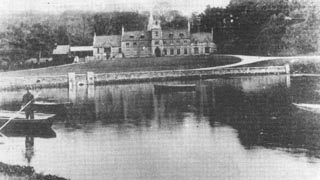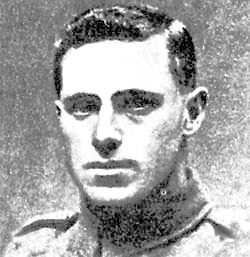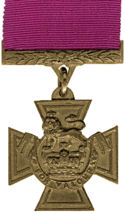 In 1891 the game keeper at Place House at St. Anthony in Roseland was 32 year old Thomas Curtis. Thomas had just moved into Cellars Cottage with his wife Catherine and their three children, Hilda, Ellard and Wilfred. One more child was to follow being born shortly after they moved in on 7th March, his name was Horace Augustus Curtis. With four young children to care for, Catherine enlisted the help of her sister, Louisa Ball, to help out. And so the tiny remote cottage on the edge of the beach at Place must have been bursting at the seams.
In 1891 the game keeper at Place House at St. Anthony in Roseland was 32 year old Thomas Curtis. Thomas had just moved into Cellars Cottage with his wife Catherine and their three children, Hilda, Ellard and Wilfred. One more child was to follow being born shortly after they moved in on 7th March, his name was Horace Augustus Curtis. With four young children to care for, Catherine enlisted the help of her sister, Louisa Ball, to help out. And so the tiny remote cottage on the edge of the beach at Place must have been bursting at the seams.
Thomas Curtis died when Horace was only four years old and the census of 1901 describes his widow as a pauper. It was around this time that the family moved out of the area as the cottage had come with the Game Keepers job. Catherine and her four children moved to Fiddlers Green near Newlyn East. Like many other young men in the area Horace became china clay worker as soon as he had completed his education.
A few weeks after the outbreak of the 1st World War, Horace travelled to Bodmin and enlisted with the Duke of Cornwall Light Infantry. Only four days later he was transferred to the 7th Battalion of the Royal Dublin Fusiliers, because of a shortage of men in that Battalion.
The Division embarked from Devonport on the 11th July 1915 aboard H.M.T. Alaunia. They called at Malta and Alexandria and landed on the island of Mitylene off the Turkish Coast on the 25th July. The Battalion then moved on to Sulva Bay Gallipoli Peninsular Turkey on the 7th Aug. After Gallipoli, the 10th Division sailed for Greece. During a long stay in the Macedonian theatre of war and bitter fighting, Horace earned promotion in 1916 from unpaid Lance Corporal, on 7th February, to fully paid Sergeant on 17th November. He was also mentioned in Dispatches in the London Gazette on 21st July 1917.
 Horace was next to see action in Palestine and was finally sent to France on 23rd May 1918. They landed at Marseilles on the 31st of that month. On 6th June his Battalion was reduced of all surplus personnel, and Horace found himself transferred to the 2nd Battalion Royal Dublin Fusiliers. France was his fourth theatre of war.
Horace was next to see action in Palestine and was finally sent to France on 23rd May 1918. They landed at Marseilles on the 31st of that month. On 6th June his Battalion was reduced of all surplus personnel, and Horace found himself transferred to the 2nd Battalion Royal Dublin Fusiliers. France was his fourth theatre of war.
On 20th June 1918 Horace returned to England where he went to Bermondsey Military Hospital in London for treatment for malaria and afterwards was able to return to his home in Fiddlers Green on 24th July; the first time in four years. He was finally cleared to return to his unit in France on 19th August and was back in France by 1st September. On the 21st he sent up to the battle front.
On 18th October 1918 aged 27, No. 14107 Sergeant Horace Augustus Curtis, 2nd Battalion Royal Dublin Fusiliers fought in action near Le Cateau that earned him the Victoria Cross. The following is the official citation, which appeared in the London Gazette on 6th January 1919.
‘No. 14107 Sergeant Horace Augustus Curtis 2nd Battalion Royal Dublin Fusiliers (Newlyn East Cornwall) for most conspicuous bravery and devotion to duty east of Le Cateau on the morning of 18th October 1918, when in attack his Platoon came unexpectedly under intense machine gun fire. Realising that the attack would fail unless the enemy guns were silenced, Sergeant Curtis, without hesitation, rushed forward through our own barrage and the enemy fire and killed and wounded the teams of two of the guns, whereupon the remaining four guns surrendered. Then turning his attention to a train-load of reinforcements, he succeeded in capturing over 100 of the enemy before his comrades joined him. His valour and disregard of danger inspired all.’
 His VC was presented to him by King George V at Buckingham Palace on 8th March 1919. Horace married in 1922 and went on to live a normal quiet live, never mentioning his wartime experiences. A biography records that, ‘he rarely spoke of his achievement humbled that he had been singled out for such an act when he had witnessed friends and colleagues carrying out similar acts of courage over those 4 long years, without official recognition, many of them losing their lives in the process. The overpowering emotion he recalled at the time of his action was one of anger.’
His VC was presented to him by King George V at Buckingham Palace on 8th March 1919. Horace married in 1922 and went on to live a normal quiet live, never mentioning his wartime experiences. A biography records that, ‘he rarely spoke of his achievement humbled that he had been singled out for such an act when he had witnessed friends and colleagues carrying out similar acts of courage over those 4 long years, without official recognition, many of them losing their lives in the process. The overpowering emotion he recalled at the time of his action was one of anger.’
Horace died aged 77 at Redruth with many of the people around him having no idea that he was a hero. His VC can be seen at the Lord Ashcroft Gallery at the Imperial War Museum in London.
Chris Pollard was born in Gerrans in 1950, and always had a big interest in local history. He started writing in 1992 and his books include Father Rang The Bell, The Old Inns Of Gerrans and Portscatho, In Search of the King, Looking back at Old St Mawes, A Cornish Life, The Book Of St Mawes and The Book of Gerrans and Portscatho. His children’s books are Living With Dennis and Christopher Teddy Bear. Also wrote for Cornwall Today and Cornish Life magazines.


Hi
Thanks to Steve (my cousin) for his comments of a man my father (Steve’s dads brother) often commented on how strong he was and how he never commented on his bravery.
It hope all connected can celebrate the 100 year anniversary.
I was planning to visit the I W museum.
Here’s a thing!
My Dad William Lesley Butler was related to Horace (Not sure how) and used to visit him on frequent trips to St Newlyn East. As I understand it dad offered to pay for Horace to attend a VC holders parade in London but Horace was too frail to attend. My Dad held his connection to HAC with pride and regarded him rightly as a hero agains a backdrop of brave men and women prepared to give their lives so that we might be free.
Dear Chris and all who replied to your article,
My name is Tom Burke. I am Chairman of the Royal Dublin Fusiliers Association. The RDFA. I live in Dublin and our RDFA s mainly a WW1 history society who keep alive the memory of the men of the RDF who died and indeed survived the dreadful tragedy of WW1. The RDF won 3 VCs in WW1 and we have attended ceremonies to commemorate the centenary of 2 of the recipients. Would anybody in Newlyn be interested in holding a ceremony to honor Sgt Curtis VC. If there is a ceremony arranged I would love to attend with our Regimental Standard. My email address is: Tom.Burke@ucd.ie
Lovely to read these comments. Horace is not forgotten and we are proud that he was born here.
Horace was a distant relative on my fathers side (great uncle), as a young boy I often looked at his photograph on the mantelpiece at Curtis cottage in Fiddlers green and wondered about him, he sadly died when I was only 6 (1969) so I only met him once that I can recall. I remember my farther saying that Horace spoke little of the war. There is a place in Newlyn named after him …..Curtis VC close
Great thanks to the website author for helping us remember a hero
Hi
Horace was my uncle – and I am proud of him. I have just started to look at the fam.ily history and just wondered who your father is.
Lynne Gittins formerly Lynne Curtis
Hi Lynne
My Father was Sydney Arthur Kiddell, His mother was Elsie Kiddell (married to Arthur Sydney Kiddell), whos sister was Esme) who lived opposite Curtis cottage in fiddlers green.
Wonderful story. We should hear more of the likes of him. The sacrifices they made for us in terrible wars to have our freedom.